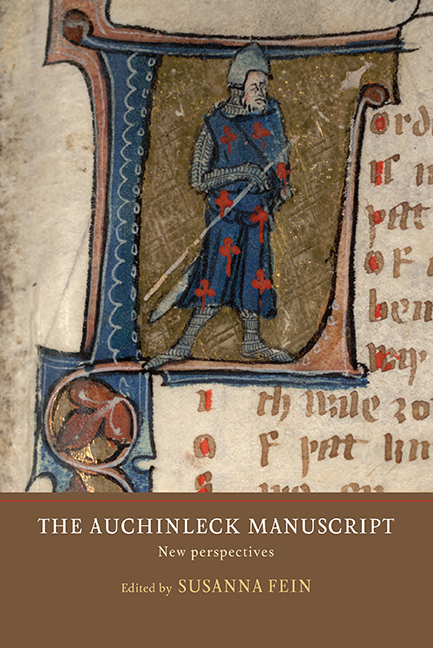Book contents
- Frontmatter
- Contents
- List of Illustrations
- List of Contributors
- Acknowledgements
- Abbreviations
- Note on the Presentation of Auchinleck Texts
- Introduction The Auchinleck Manuscript: New Perspectives
- 1 The Auchinleck Manuscript Forty Years On
- 2 Codicology and Translation in the Early Sections of the Auchinleck Manuscript
- 3 The Auchinleck Adam and Eve: An Exemplary Family Story
- 4 A Failure to Communicate: Multilingualism in the Prologue to Of Arthour and of Merlin
- 5 Scribe 3’s Literary Project: Pedagogies of Reading in Auchinleck’s Booklet 3
- 6 Absent Presence: Auchinleck and Kyng Alisaunder
- 7 Sir Tristrem, a Few Fragments, and the Northern Identity of the Auchinleck Manuscript
- 8 The Invention of King Richard
- 9 Auchinleck and Chaucer
- 10 Endings in the Auchinleck Manuscript
- 11 Paraphs, Piecework, and Presentation: The Production Methods of Auchinleck Revisited
- 12 Scribal Corrections in the Auchinleck Manuscript
- 13 Auchinleck ‘Scribe 6’ and Some Corollary Issues
- Bibliography
- Index of Manuscripts Cited
- General Index
- Manuscript Culture in the British Isles
9 - Auchinleck and Chaucer
Published online by Cambridge University Press: 21 May 2021
- Frontmatter
- Contents
- List of Illustrations
- List of Contributors
- Acknowledgements
- Abbreviations
- Note on the Presentation of Auchinleck Texts
- Introduction The Auchinleck Manuscript: New Perspectives
- 1 The Auchinleck Manuscript Forty Years On
- 2 Codicology and Translation in the Early Sections of the Auchinleck Manuscript
- 3 The Auchinleck Adam and Eve: An Exemplary Family Story
- 4 A Failure to Communicate: Multilingualism in the Prologue to Of Arthour and of Merlin
- 5 Scribe 3’s Literary Project: Pedagogies of Reading in Auchinleck’s Booklet 3
- 6 Absent Presence: Auchinleck and Kyng Alisaunder
- 7 Sir Tristrem, a Few Fragments, and the Northern Identity of the Auchinleck Manuscript
- 8 The Invention of King Richard
- 9 Auchinleck and Chaucer
- 10 Endings in the Auchinleck Manuscript
- 11 Paraphs, Piecework, and Presentation: The Production Methods of Auchinleck Revisited
- 12 Scribal Corrections in the Auchinleck Manuscript
- 13 Auchinleck ‘Scribe 6’ and Some Corollary Issues
- Bibliography
- Index of Manuscripts Cited
- General Index
- Manuscript Culture in the British Isles
Summary
THIS paper is not about whether Chaucer knew the Auchinleck manuscript. It asks what looking from Auchinleck to Chaucer might reveal about Chaucer, and perhaps about Auchinleck.
Compilation analogies
Chaucer's Canterbury Tales is among other things a manuscript anthology. For both its frame story, with exchanges between pilgrim narrators and listeners, and its sequencing of items, his inspirations surely included manuscript compilation as much as real-life pilgrims’ storytelling and chatting or literary tale-collections. The Auchinleck manuscript (Edinburgh, NLS, MS Advocates 19. 2. 1), and also London, British Library, MS Harley 2253, prefigure Chaucer's Tales in several aspects of their compilation. Two such aspects become in Chaucer's hands highly creative. One is their use of narrator/listener passages on the borders of items: headlinks and endlinks containing formulaic appeals, ‘Listeth lordes … And I wol telle’ (VII 712–13), with variants, including (in Auchinleck) copious prayers. In Auchinleck, these formulae appear fairly regularly between items (where openings or endings survive), contributing a sense, albeit limited, of unity of tone to junctures between texts. The ‘I’ who speaks and the ‘ye’ who are asked to listen are never individualized, contributing further regularity to these passages. Between his own anthology's items, Chaucer creates a dramatized framework of individualized narrators and listeners. Consequently, the narrator/listener relationship becomes two-way and introduces responses from the listeners. When combative, such responses can intensify contrastive sequencing of tales.
A second compilatorial element Chaucer's Tales shares with Auchinleck and Harley is subtle juxtapositioning, which offers readers the option of perceiving parallels and contrasts between items. This differs from the obvious thematic or generic grouping basic to the Vernon manuscript's design and frequent in Auchinleck: for example, two saints’ lives or three Guy of Warwick romances together; On þe Seuen Dedly Sinnes with The Pater Noster Vndo on Englissch; or eschatological subjects in items ‘xi’ and ‘xii’. Carter Revard shows ‘oppositional thematics and metanarratives’ informing subtle sequencing in Harley; Susanna Fein finds its compiler offering audiences diptych-like or longer combinations, whose effect is ‘a progressive entertainment’, actual or imagined. The ‘act of compilation builds meaning without making an authoritative comment’, a description that captures exactly a technique central to Chaucer's distinctive management of structures and his self-presentation as author.
- Type
- Chapter
- Information
- The Auchinleck Manuscript: New Perspectives , pp. 139 - 155Publisher: Boydell & BrewerPrint publication year: 2016
- 2
- Cited by



